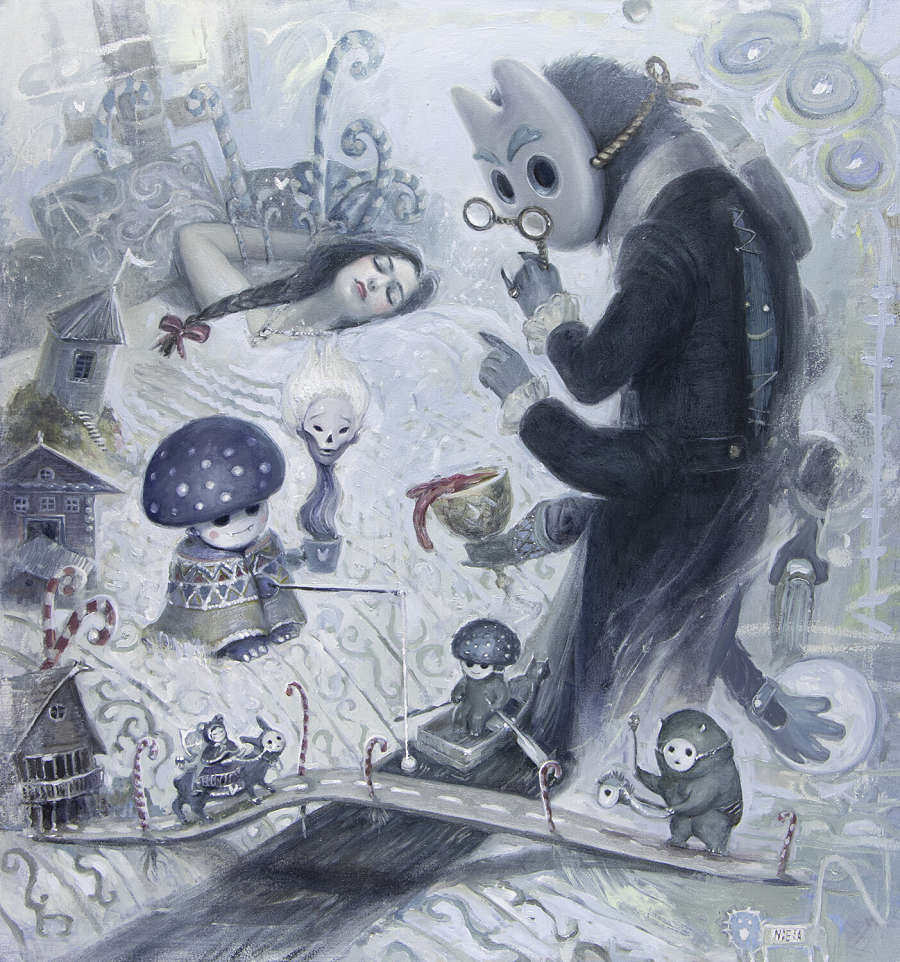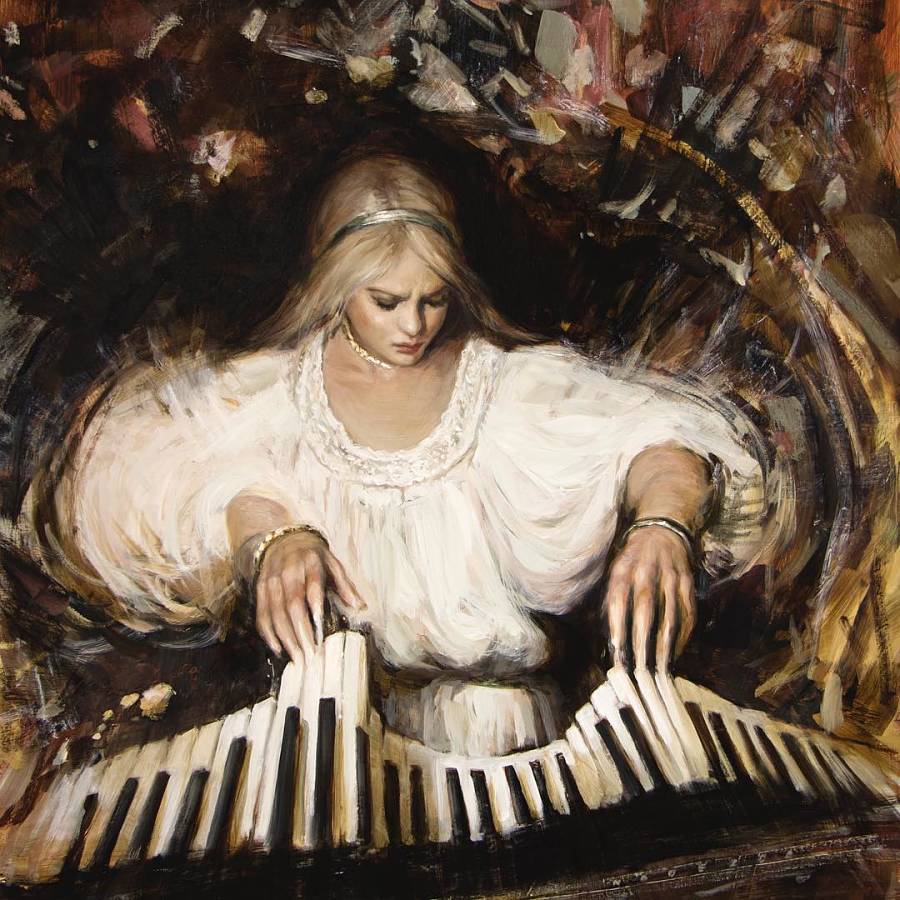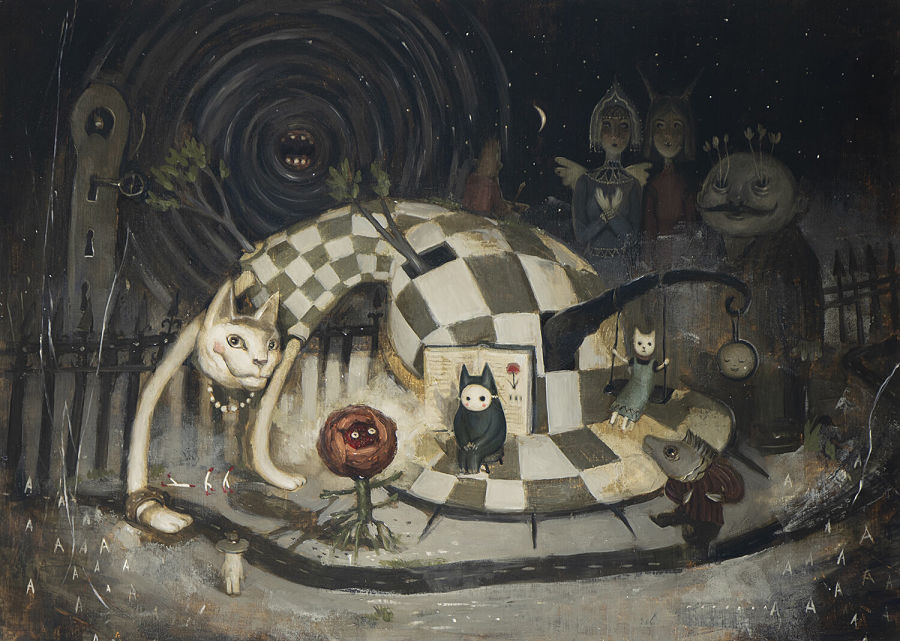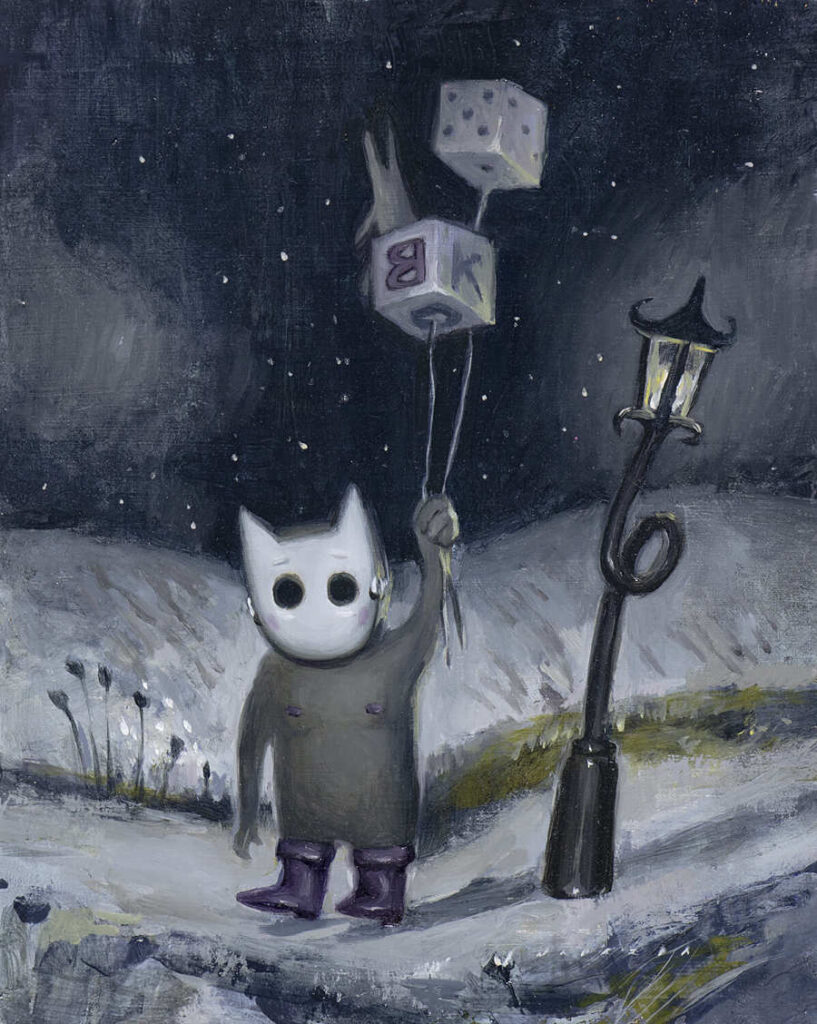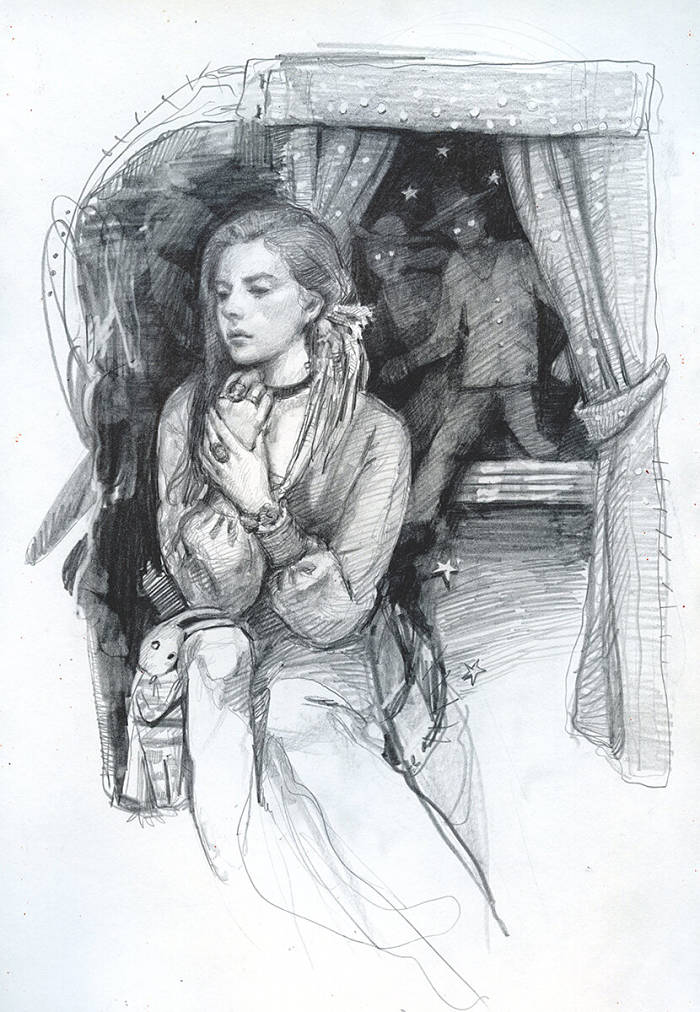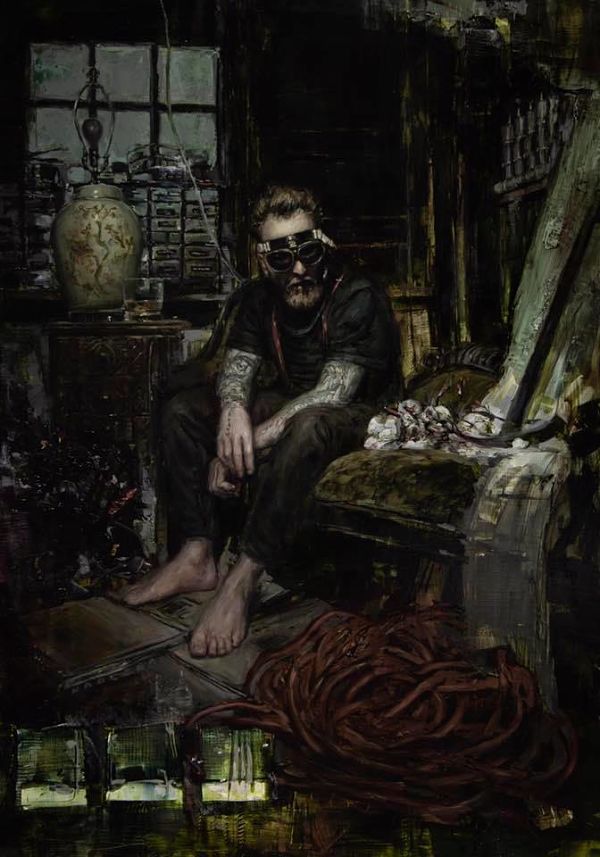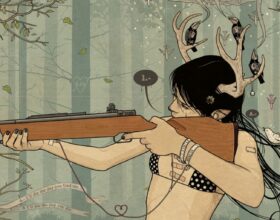Nadezda is a Russian-born artist, currently based in the Bay Area of California. Her artwork is definitively surreal. Other realms are created with paint and graphite, which represent a dream or the depths of her subconscious. These worlds contrast highly imagined characters with elements of realism. However, her work can also favor realism with a hint of surrealism poking through. There is always a push and pull of the two elements.
Her artistic antennae are always working and she readily finds inspiration from the world around her. Allegory and imagination are important aspects of her work. A man sleeping on a train car ignites her artistic mind just as easily as a carefully planned photo shoot. Nadezda is inspired by the realness of a moment and finds it imperative to make a conscious effort to exercise her imagination muscle.
Nadezda recognizes the influences of growing up in Northern Russia. Folklore, harsh winters, the beauty of the northern lights, and theater are all nestled deep in her subconscious and have therefore reemerged in her paintings and drawings. These influences of her early childhood have in many ways shaped her as an adult and driven her down the artistic path. She states, “The things you surround yourself with feed into your subconscious.”
Continue reading to discover more about Nadezda and her artwork.

“Dissonance” oil on panel 
“Apples in February” oil on panel
I grew up in European North of Russia, where winter is cold, dark and long, and summer is short and very bright, where the sun only dips behind the horizon for a quick moment and then continues its journey across the sky. Such climate and long winters seemed to inspire creativity in my family. My mom, dad, brother and I would often get together with family friends and there would always be singing and live music by the dinner table. Since age seven, I was acting in theater together with my whole family. Every weekend was full of wonderful transformations into characters and creatures, mostly from Russian and Western European fairy tales. It was an enchanting experience to travel into the imaginary world together with other actors and create a realm of wonder for the audience to come along.

My grandmother, who comes from Siberia, had a big influence on me when I was a child. Her home is decorated with paintings, plates and masks of Siberian and Mongolian mythical creatures. She used to tell me stories of Lake Baikal and his daughter, River Angara, who ran away against her father’s will to her beloved Yenisei (also a Siberian river). Out of anger, Baikal threw a big mountain rock after Angara, but it was too late, as Angara and Yenisei have already embraced each other by then to be together – Shaman Stone (Shaman Kamen) is still visible at the place where the river flows away from the lake. Such stories about the forces of nature represented as human mythical characters had a big influence on me as a child. So did the Mongolian creature masks, which were observing quietly from the walls of her home, protecting it, as she said, from the unwelcome spirits. My grandma introduced me to poetry and playful logic games, too, when I was very young. Like the one about the mouse, who lives in a wall. She would say, “The wall has got a mouse, the mouse has got ears, therefore the wall has got the ears, too”. It sounded funny and at the same time I was fascinated by the way she twisted the logic of things and immediately imagined huge ears growing out of the wall.

“Alchemy”, oil on panel, 2020 
“Square Balloons”, oil on panel, 2020
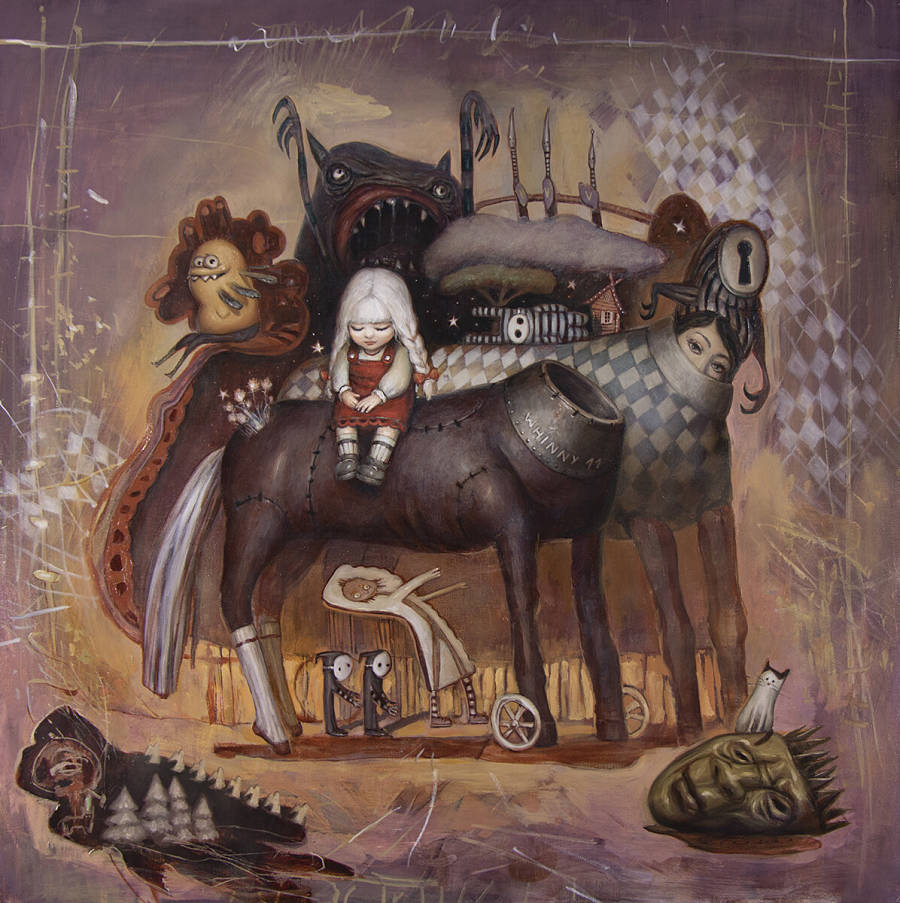
There seems to be a surreal and dreamlike element to your work, how would you say the surreal plays into your work?
My early introduction to mind-bending narratives happened when I was a child – I read stories written by the local folk storyteller Stepan Pisakhov. His tales, full of intentionally illogical situations that imaginary characters and creatures put themselves into, boggled my young mind and sent my imagination flying. I was also introduced to the surreal poetry of Vladimir Mayakovsky, whose books have been permanent residents in my studio library. I was inspired to write my own poetry, even published a book, and later I transitioned to capturing my ideas with paint rather than words.
I practice the flight of imagination even when I am outside of the studio, especially if life presents seemingly boring situations – often by will alone one’s imagination can transform the mundane into magical. Here is an example of one of such observations I wrote down (and sketched) while staying in a beautiful, windy summer room of an Italian hotel.
Wind People
We were staying at the house of many winds. It sounded like being inside of a deserted trumpet. The wind people come and go through our windows – bowing, murmuring, rushing out from the opposite end of the room. Other times they argue, then apologize in whispers, leaving only curtains gently dancing. (September, 2019)
Navigator
I am a Navigator. There is a keyhole in your head that leads to the vault of stories – I will be there, in the intersection, summing up your dreams. The corners are folding and it’s hard to get through the bottle neck of the nightmare, but I’ll handle it, because I am an Ace of getting out of the tacky latitudes. (July, 2019)

“Wind People” 
“Navigator”, oil on panel
Sometimes they will be as short as one phrase or a sentence, such as “The Terrible Dream”. Sometimes when I go plein air painting and not in the mood to paint, I portray it with imagined storiesm such as “The Vertical Village”.
The Terrible Dream
A fingernail shrinking and disappearing completely. (2019)
The Vertical Village
There is a village I see far away resting in a blanket of Italian trees. It looks quiet and peaceful with only one road crossing through it. As the clock ticked noon the land on which the village stood ripped itself from the landscape and turned sideways, perpendicular to the ground. A cloud came down from the mountain – it hovered towards the vertical village and showered it with rain. “A-ha!” – I said, – “This is a street cleaning day!” The village lowered itself back into its original placement – all clean, wet and sparkling like new. What a fresh day! (September, 2019)
The surreal part happens when I let the conscious thinking and intuition blend in my process. For a long time, I have been building up trust between the two. That’s why those scribbled ideas in the sketchbook are so important, because they are a gift from within that is given to the conscious mind to decipher and bring them to life. Such collaboration of creative intuition and analytical thinking is what shapes the surreal feeling of my work.

What do you find inspiring about surrealism and or dreams? Also, is any of your work inspired by your own dreams? If so do you keep a dream journal?
I don’t have a dream journal; I don’t find my dreams particularly interesting. I am more curious about the workings of the intuitive part of the brain that helps to solve creative problems and come up with new ideas. It’s not a technique, but rather a lifelong practice that helps to access and take care of the creative treasure hidden within. It is also a boredom-proof approach for any seemingly mundane life situations that offers a source of inspiration and only takes turning on the imaginative gears.
I have noticed a lot of imagined characters that you have created, how do you come up with these characters and ideas?
In my creative process, things unfold in parallel, patiently giving each other the right to go. I always carry a sketchbook with me everywhere I travel and collect new ideas for my paintings in a form of very primitive, yet significant and dear to me kind of scribbles. They are the first important physical step to the creation of a painting. Sometimes I also write short stories that go along with the ideas, to make the “roots” of these painting ideas stronger. Those scribbles might sit in a sketchbook for months until I revisit them to find the inspiration for the next piece. Then I would take one of those scribbles for further development and preliminary studies, which help to complete the final piece. The trick is that such ideas can’t be forced, they usually let me know when they are ready. And I make sure to be ready for them with pen and paper to receive the creative transmission from within.
Would you like to talk about the photo shoot process and how it plays a role in developing an artwork and composition?
The photo shoot is a very important ingredient in my process when I work on a piece that is figure-based. The unique subtlety of gesture and the energy of the pose performed by a real model is a true gem. For each shoot I have a vague idea of what I want to try in the realms of costume, mood, set and props and have them prepared beforehand along with the memo sketches of the ideas. When the model appears on “stage”, all those elements start singing together in a semi-improvised performance. I don’t like to direct my models too heavily, I believe in a symbiosis of their creativity and mine, which brings wonderful and unexpected results. Of course, the music is a tuning fork for the mood of the scene; without the music the process would fall apart.

“A Little Light Melody for The Tired Ears”, oil on panel 
“Sazerac”, oil on moleskine
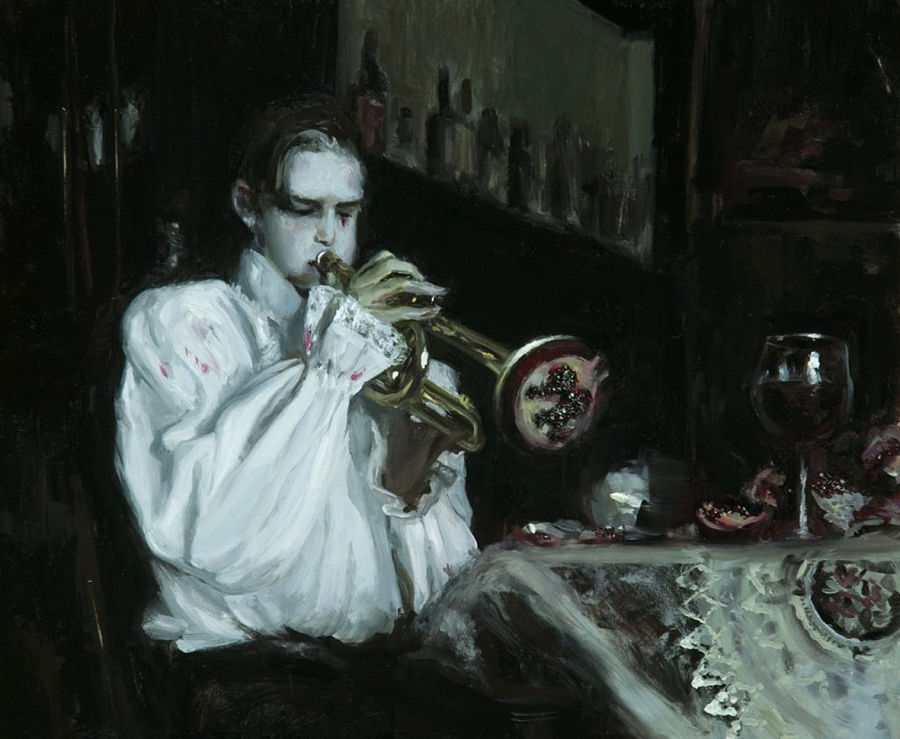
What do you enjoy most about plein air painting and what benefits do you believe it offers?
Lately, I have not been doing much plein air painting. Even if I am outdoors with fellow painters, I prefer to use that time to think and write, to let my mind travel across the scenery when wandering in the woods or fields, to people watch when traveling the world, listening to the murmur of little European towns and sounds of nature. My creative schedule is usually very busy, making such time absolutely precious. It is important to take the brain outside of the studio and other familiar settings and let it absorb some new energy that the outside world generously offers. After such plein air thinking, a lot of new ideas pop up as gifts from the rested mind.

What is your favorite subject to paint?
My subjects for painting are diverse; characters, creatures, situations, environments, real and made up – the main criteria is that they have to transmit a strong mood and emotion. It is hard to explain how I choose one over another, I just follow my intuition without allowing any of them become a favorite.
There seems to be some recurrent symbolism in your work, such as watermelons, masked figures, musical instruments, etc. What do these symbols mean to you and your artwork?
I would not call it symbolism because they don’t stand for any secret meaning. It’s just like I mentioned earlier, I paint what I like. Sometimes I like watermelons, musical instruments and vintage phones and so I put them in the scene. Sometimes I like masks and so I make them a part of the costume. I am actually making a mask for a new character at the moment – it is red and made of papier-mâché, glass and wool, sitting on the face of the mannequin and eerily watching me as I write this.

“Bad Seed”, oil on panel 
“Sound of a Minute”, oil on panel
What is your favorite part about being an artist?
The ability to create all day every day and bring to life something that has never existed before is delightful and freeing. Existing in this way is my favorite way to exist.
How do you feel you have evolved as an artist over the years?
I have become a more confident and aware person, so really being an artist over the years has helped me evolve as a human.
Where do you wish to take your artistic career in the future?
I don’t think of art as a career. For me, it’s a way of living life. And so I hope with all the years I’ll be gifted to spend on this planet, I will be spending them creating.
